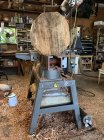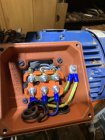Hey Emiliano, I'd happy to come to Maui - if you have space on your couch!
I spent a month in Kauai a few years ago and fell in love. No heating, no A/C just perfect weather 300 days a year. And great wood to turn....ah...paradise.
You have ordered the parts, so are locked into that course of action, but, in the meantime, maybe as Bill suggest, check all the mechanical stuff (if you have not done so already)
- belts slipping
- spindle slipping
Have a friend watch the two shafts, as you stall the wood blank. See if either show slippage. If not, all the issues should be at the motor.
Check for excessive resistance / friction:
- spin the spindle by hand checking for friction.
If there is a lot, then drill down. It could be the lathe, spindle or motor bearings or the belt rubbing (not likely)
I can't think of any other mechanical problems.
So it might be the motor's insulation has gone bad, as Bill suggests. I've never had it happen, but I defer to his greater experience on this. My own reading of the Baldor documents, confirms his statements.
You also mention that your VFD might rated for 2 hp, while the motor is 3 hp.
I.e. the VFD would not supply enough AMPs for full power. Thats VERY possible. On my VFD's (Delta) brand, that usually triggers an error for overload. You'll have to check your own brand.
Lastly, is this a "converting VFD"? I.e
1 - is it plugged into a 220v single phase circuit? Or
2 - do you have a Phase Converter upstream that creates a 3 phase solution for your shop
This is critical. Because if #1, then your VFD will almost guaranteed not be able to supply enough AMPs to the motor. and that my be your issue.
The optimal setup is a Rotary Phase Converter (RPC), for all your machines, so they have lots of clean 3 PH power.
Then use VFD's to control the speed. RPC's are cheap and easy to build, especially if you have a big ol' 3 PH motor spare.
Additionally, there's a great bunch of people at OWWM. They specialize in restoring old machines - which means tackling a ton of tricky issues. OK -your Stubby is not old, but they will try to help and have tones of experience with VFDs / motors, 3 PH, RPC.
http://www.owwm.org/viewforum.php?f=82&sid=0d775e02fe3d80ed5e07c1dc1cc216b4
They will run you through a similar checklist, as above.
Lastly, while you are waiting, possibly consider a different turning tool. I often use an Oland tool
View: https://www.youtube.com/watch?v=gbNst5EvsG4
for removing large amounts
Its a smaller cutting tip, so requires less HP, and still removes a lot, very fast.
But leaves a poor surface, so you need to follow up with a nice finishing cut.
Let us know how you are setup and maybe I can help further in trouble shooting.




